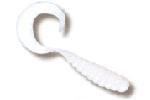 | ||
A plastic worm (or trout worm) is a plastic fishing lure, generally made to simulate an earthworm. Plastic worms can carry a variety of shapes, colors and sizes, and are made from a variety of synthetic polymers. Some are even scented to simulate live bait.
Plastic worms can be rigged on the line many different ways. Commonly they are used with a small fish hook and a split shot weight to keep the lure deeper in the water. The fishing equipment recommended is a 7-foot fishing rod with 8 to 10 lb fishing line.
A common fishing strategy is to configure them as a Texas Rig, and bounce them off the bottom. The key is to jig near or in cover such as weeds and trees, this technique is commonly referred to as flipping and pitching.
"Twister Worm" is commonly called a grub, not a "twister worm", even though the action of the tail is defined as a twisting motion of the body resembling that of a grub.
Generally there is but one type of worm, the plastic worm. This worm comes in a variety of lengths, styles, and colors to attract different fish species. Ironically, the plastic worm, sometimes called a "trout worm ", is often unreliable as a lure for trout fishing, and therefore many anglers do not use them for trout fishing. Bass and panfish species (bluegill, sunfish, etc.) tend to bite these lures more than other species.
